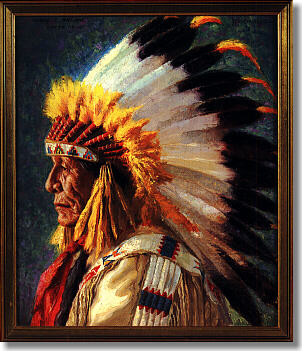Osage County, OK
 From early tribal tradition, and from the research of archaeologists and historians, and the ancestors of the Osage, we know that this tribe of Indians was closely affiliated with the Siouan, or Dhegiha tribes,
From early tribal tradition, and from the research of archaeologists and historians, and the ancestors of the Osage, we know that this tribe of Indians was closely affiliated with the Siouan, or Dhegiha tribes,their dialect being much the same.
The name, Osage, is a corruption of the tribal name, Wa-Zha-Zhe, that the Indians used themselves, the meaning and derivation is not clear.
The first recorded note of the Osage was by Marquette in 1673. His writing placed them on the Osage River in present Vernon County, Missouri, where they were still established, nearly 100 years later in 1759.
There is little known about the Osage from this time until the treaty at St. Louis in 1804. Here we find the explorers and French traders marrying into the Osage tribe. Almost from the beginning, trading with the Indians became a lucrative enterprise, for the white man and the spead of trade brought a large number of tribes into contact with the French, Spanish and English. All groups trying to make allies among the Indians.
The Osage signed their first treaty with the United States in 1808, ceding to the Federal Government lands new comprising over half the state of Missouri and northern Arkansas, including their old village located on the Little Osage River.
When the Osage signed the treaty of 1825 at St. Louis, they ceded all their lands to the United States, all of Oklahoma north of the Arkansas and Canadian Rivers, northwestern Arkansas, western Missouri and nearly half of Kansas.
Osage County today is the largest county in Oklahoma. Big Prairie? Imagine the vastness of 37,000 acres of prairie, disturbed only by the thunder of more than 800 bison. This is the Nature Conservancy's Tallgrass Prairie Preserve, lying just 17 mile north of Pawhuska. At one time, the American prairie spanned across fourteen states. Now, less than 10% of this original prairie remains, but the prairie surrounding Pawhuska is still flourishing. On the Tallgrass Prairie alone, over 600 plant, 300 bird, and 80 mammal species have been identified. Film teams from around the world have discovered the Tallgrass Prairie as a place of ecological richness and uncommon beauty.
Real Cowboys? Over 250,000 head of cattle thrive on the bluestem grass on over 1,000 ranches around the county. Numerous rodeos and ropings throughout the year give these real American cowboys the chance to showcase their immense skill to the public.
Explore Osage County
Superintendent's Home
Superintendent's Home has been the residence to 30 Osage Agency Superintendents. In 1994, the home was turned into administrative offices for the recently formed Osage National Council. This building is constructed of sandstone quarried in Osage County and is listed on the
Pawhuska, OK Ethnic HeritageTriangle Building
This is a rare, free-standing triangle building. As early buildings in Pawhuska were constructed, a triangle-shaped piece of land was left in the middle of town. It was a park with a two-story bandstand in the center. In 1915, this five-story, "flat-iron"
Pawhuska, OK Historic BuildingsShady Brook Home
Built about 1900 by an early merchant, the home was originally located a number of feet east of its present location. When the town was platted and streets laid out in 1905, the house sat in the street. The home was purchased about 1910 by Dr. J.J. Fraley, an early physician. In the 1980
Hominy, OK Historic HomesFirst National Bank Historic Site
The First National Bank is on the site of the second Osage Agency as the original log cabin in the valley burned. The Osage Tribe built a hand-cut sandstone two-story building which housed the agency and commissary. In 1924, this current structure was built.
Pawhuska, OK Ethnic HeritageMarland Oils Building
Hominy's 1921 Marland service station is one of the few surviving examples of the popular triangle design utilized by the old Marland Oil Company (now Conoco). The building is under restoration by the Hominy Heritage Association.
Hominy, OK Historic Buildings
The Victorian Theater
The Victorian Theater is a groundbreaking, exciting new concept in combining fine dining, entertainment and retail sales all located in one facility designed to bring patrons the ultimate multisensory experience.
Pawhuska, OK Dinner TheatresImmaculate Conception Catholic Church
This church is known widely as the "Cathedral of the Osage". Special permission from the Vatican had to be granted to depict living tribal members in the glorious stained glass that was crafted in Munich, Germany in 1919
Pawhuska, OK Historic ChurchesRexall Drug Store
Constructed in 1907, the building has always served the community as a drug store. Its affiliation with Rexall dates to the 1920s. The second floor was used for many years by various professions including law, dentistry, and photography.
Hominy, OK Historic BuildingsBoy Scout Monument
The first boy scout troop in America was organized in Pawhuska, Osage County, Oklahoma, in May, 1909
Pawhuska, OK MonumentsOsage Indian Heritage
From early tribal tradition, and from the research of archaeologists and historians, and the ancestors of the Osage, we know that this tribe of Indians was closely affiliated with the Siouan, or Dhegiha tribes, their dialect being much the same.
Pawhuska, OK Ethnic HeritageDowntown National Historic Register District
The historic district in Pawhuska is comprised of 98 buildings, 86 of which are listed on the National Register of Historic Places. These two and three-story brick structures, along with a five-story triangle building, provide an impressive tribute to days gone by.
Pawhuska, OK Historic Districts